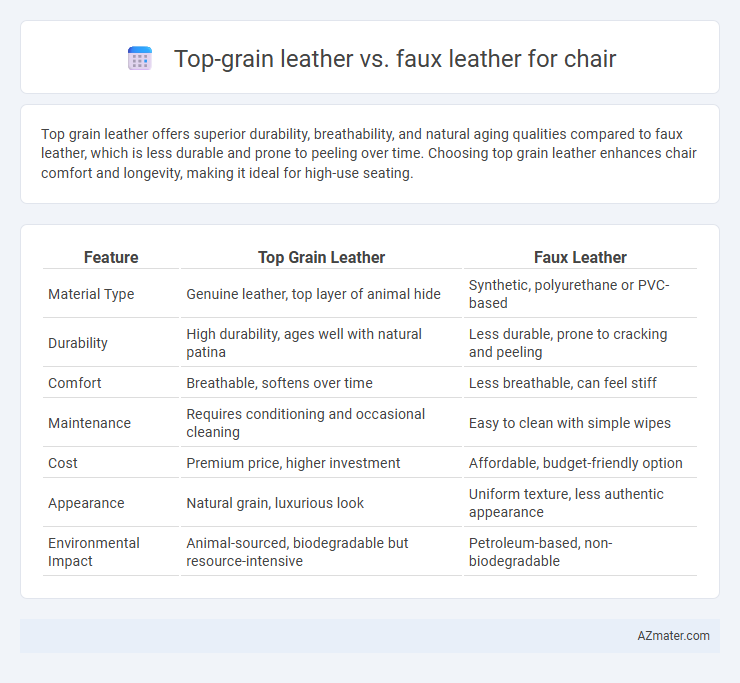Top grain leather offers superior durability, breathability, and natural aging qualities compared to faux leather, which is less durable and prone to peeling over time. Choosing top grain leather enhances chair comfort and longevity, making it ideal for high-use seating.
Table of Comparison
| Feature | Top Grain Leather | Faux Leather |
|---|---|---|
| Material Type | Genuine leather, top layer of animal hide | Synthetic, polyurethane or PVC-based |
| Durability | High durability, ages well with natural patina | Less durable, prone to cracking and peeling |
| Comfort | Breathable, softens over time | Less breathable, can feel stiff |
| Maintenance | Requires conditioning and occasional cleaning | Easy to clean with simple wipes |
| Cost | Premium price, higher investment | Affordable, budget-friendly option |
| Appearance | Natural grain, luxurious look | Uniform texture, less authentic appearance |
| Environmental Impact | Animal-sourced, biodegradable but resource-intensive | Petroleum-based, non-biodegradable |
Introduction: Understanding Top Grain Leather and Faux Leather
Top grain leather is crafted from the upper layer of animal hide, offering durability, breathability, and a natural texture that enhances with age, making it a premium choice for chairs. Faux leather, composed of synthetic materials like polyurethane or polyvinyl chloride, mimics the look of real leather while providing a more affordable, water-resistant, and low-maintenance alternative. Both materials serve distinct purposes in chair upholstery, balancing aesthetics, comfort, and cost, which helps consumers make informed decisions for their home or office seating.
Material Composition: What Sets Them Apart
Top grain leather, derived from the upper layer of cowhide, offers natural durability, breathability, and a unique grain pattern that enhances over time. Faux leather consists of synthetic materials, typically polyurethane (PU) or polyvinyl chloride (PVC), designed to mimic real leather's appearance while providing water resistance and easier maintenance. The primary difference in material composition lies in top grain leather being a natural product with inherent toughness, whereas faux leather is entirely man-made, emphasizing affordability and versatility.
Durability: Which Lasts Longer?
Top grain leather offers superior durability compared to faux leather, maintaining its strength and appearance over many years due to its natural fibers and resistance to wear and tear. Faux leather, made from synthetic materials like polyurethane, tends to degrade faster, especially with constant use and exposure to sunlight or heat. While top grain leather can develop a desirable patina enhancing its longevity, faux leather often peels or cracks, making it less durable for chair upholstery.
Comfort and Feel: Texture and Experience
Top grain leather offers a natural, breathable texture that adapts to body temperature, providing superior comfort and a luxurious feel ideal for prolonged seating. Faux leather, made from synthetic materials, often feels less supple and can trap heat, resulting in a less comfortable and less authentic tactile experience. The natural grain and softness of top grain leather enhance ergonomic support, making it the preferred choice for high-end chairs.
Aesthetic Appeal: Visual Differences Explained
Top grain leather showcases a rich, natural texture with unique grain patterns and subtle color variations, offering a sophisticated, timeless aesthetic ideal for high-end chairs. Faux leather presents a uniform, smooth surface with consistent color, providing a sleek, modern look that can mimic genuine leather but often lacks the depth and character of real hide. The visual difference lies in top grain leather's organic imperfections and patina development, contrasting with the synthetic, matte or glossy finish of faux leather.
Maintenance and Care Requirements
Top grain leather chairs require regular conditioning with specialized leather conditioners to maintain suppleness and prevent cracking, along with gentle cleaning using damp cloths to avoid damage. Faux leather chairs demand less intensive care, needing only occasional wiping with mild soap and water to remove dirt and stains, but they are more susceptible to peeling and cracking over time. Choosing top grain leather means committing to routine maintenance for durability, whereas faux leather offers easier upkeep but shorter lifespan.
Environmental Impact and Sustainability
Top grain leather is biodegradable and derived from animal hides, but its production involves significant water use, chemical treatments, and greenhouse gas emissions, raising sustainability concerns. Faux leather, typically made from polyurethane or polyvinyl chloride, requires less water and animal resources but relies on non-renewable petroleum products and generates microplastic pollution. Choosing between these materials involves balancing durability and environmental impact, with emerging plant-based and recycled leather alternatives offering more sustainable solutions.
Price Comparison: Cost to Value Ratios
Top grain leather chairs typically command higher prices ranging from $300 to $700 due to their durability, natural texture, and breathability, offering long-term value through longevity and comfort. Faux leather chairs are more budget-friendly, often priced between $100 and $300, providing an affordable and low-maintenance alternative but with less durability and tendency to wear faster. The cost-to-value ratio favors top grain leather for buyers seeking investment quality and comfort, while faux leather suits those prioritizing initial affordability and ease of cleaning.
Common Applications in Chair Design
Top grain leather is frequently used in premium office chairs and executive seating due to its durability, natural texture, and ability to develop a rich patina over time, enhancing comfort and aesthetics. Faux leather, made from polyurethane or PVC, is popular in budget-friendly and contemporary chair designs, offering easy maintenance and resistance to stains and scratches. Both materials are chosen based on application needs, with top grain leather preferred for luxury and longevity, while faux leather suits high-traffic environments requiring cost-effective and versatile solutions.
Which Is Best for Your Needs?
Top grain leather offers superior durability, natural breathability, and a luxurious feel, making it ideal for long-lasting chairs in high-use environments. Faux leather provides a more affordable, easy-to-clean alternative, with resistance to stains and scratches, suitable for budget-conscious buyers or spaces prone to spills. Choosing between top grain and faux leather depends on your priorities for longevity, comfort, maintenance, and budget.

Infographic: Top grain leather vs Faux leather for Chair
 azmater.com
azmater.com